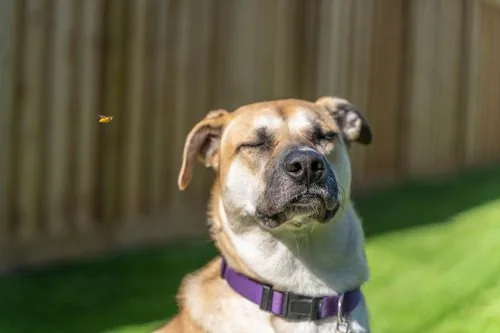My Dog Got Stung By a Bee – What Should I Do?
Bees are fascinating creatures, but their stings can cause quite a stir, especially for our canine companions. If your dog has been stung by a bee, you may feel a rush of concern and a flood of questions. While a bee sting can be painful and sometimes dangerous, knowing what to do can help you remain calm and ensure your dog gets the care they need.

Understanding the Bee Sting
When a dog gets stung by a bee, the sting itself injects venom into the skin. This venom causes immediate pain and can lead to swelling and redness at the site of the sting. Dogs, being naturally curious, often get stung on their face, mouth, or paws. Depending on the dog’s reaction to the venom, symptoms can range from mild discomfort to severe allergic reactions.
Identifying a Bee Sting
If your dog yelps suddenly and begins pawing at their face or licking a specific area, they may have been stung. Look for a small, swollen bump, which is often red and may still have the bee’s stinger attached. Other common signs include:
- Swelling around the sting area
- Redness and inflammation
- Licking or scratching the site
- Whimpering or showing signs of pain
Recognizing an Allergic Reaction
While most dogs experience mild symptoms after a bee sting, some can have severe allergic reactions. It’s crucial to recognize these signs so you can act swiftly. Symptoms of an allergic reaction include:
- Excessive swelling, particularly around the face and throat
- Difficulty breathing or wheezing
- Vomiting or diarrhea
- Weakness or collapse
If your dog shows any of these signs, seek immediate veterinary care by calling us at (707) 462-8833 or booking an appointment online.
Immediate Actions to Take
Once you’ve identified that your dog has been stung, there are steps you can take to provide immediate relief and prevent further complications.
Removing the Stinger
If the stinger is still visible, try to remove it as quickly as possible. Use a flat object like a credit card to scrape it out, rather than using tweezers, which can squeeze more venom into the skin. Removing the stinger helps reduce the amount of venom injected.
Applying a Cold Compress
To reduce swelling and provide relief, apply a cold compress or ice pack to the sting site. Wrap the ice pack in a cloth and hold it gently against the area for about 10-15 minutes. This can help minimize pain and inflammation.
Monitoring Your Dog
After addressing the immediate sting, it’s important to keep a close eye on your dog for the next 24-48 hours. Monitor their behavior and look for any signs of an allergic reaction or worsening symptoms.
Hydration and Comfort
Ensure your dog stays hydrated and comfortable. Offer them water and keep them calm to help reduce stress. Avoid letting them scratch or lick the sting site excessively, as this can cause further irritation or infection.
When to Visit the Vet
Even if your dog seems to be handling the sting well, it’s always a good idea to consult with a veterinarian, especially if it’s their first sting. Our team at Mendocino Animal Hospital is here to help you. Call us at (707) 462-8833 or book an appointment online if you have any concerns or if your dog’s symptoms worsen.
Preventing Future Bee Stings
While it’s impossible to completely protect your dog from bee stings, there are measures you can take to reduce the risk.
- Avoiding High-Risk Areas: Bees are most active during the warmer months and around flowering plants. When taking your dog for walks, try to avoid areas with lots of flowers or beehives. Keep an eye on where your dog is sniffing and exploring.
- Training and Supervision: Training your dog to come when called and supervising them during outdoor activities can prevent them from disturbing bees. Teach them to avoid chasing or snapping at flying insects.
- Seeking Professional Advice: If your dog has a history of severe reactions to bee stings, your veterinarian may recommend carrying an epinephrine auto-injector (EpiPen) and can provide instructions on how to use it in an emergency.
Understanding the Long-Term Effects
Most bee stings will resolve without lasting issues, but it’s important to be aware of potential long-term effects, especially if your dog experiences multiple stings or severe reactions. Repeated stings can sometimes lead to increased sensitivity to bee venom. If your dog has been stung multiple times, discuss this with your vet to determine if additional precautions are needed.
Caring for Your Dog Post-Sting
After a bee sting, your dog may feel sore or anxious. Providing extra care and comfort can help them recover more quickly.
Pain Management
Your vet may recommend or prescribe pain relief medication if the sting causes significant discomfort. Never give your dog over-the-counter medications without consulting your vet first.
Monitoring for Infections
Keep an eye on the sting site for signs of infection, such as increased redness, swelling, or pus. If you notice these signs, contact Mendocino Animal Hospital for advice.
Supporting Your Dog Through a Bee Sting
Bee stings can be a worrying experience for both you and your dog, but with the right knowledge and actions, you can manage the situation effectively. If your dog gets stung by a bee, staying calm, providing immediate care, and knowing when to seek veterinary help are crucial steps. Our team at Mendocino Animal Hospital is always here to support you and your pet. Call us at (707) 462-8833 or book an appointment online for any concerns or further guidance.
Recent Posts
Dog UTI Symptoms
Urinary tract infections (UTIs) can affect dogs of any age, breed, or size—and when they do, it…
Ear Mites in Cats
If your cat has been shaking their head, scratching around their ears, or showing signs of discomfort,…
Can Dogs Have Cheese?
Many pet owners enjoy sharing small bites of their favorite snacks with their dogs—especially something as tempting…
What Do Dogs Dream About?
Have you ever watched your dog sleeping—legs twitching, nose wriggling, tail flicking—and wondered what’s going on in…
Is it Normal That My Dog is Snoring?
Dogs snoring can be adorable, but it can also raise concerns for pet owners. If you’re wondering,…
About Mendocino Animal Hospital
At Mendocino Animal Hospital, we believe in fostering the human-animal bond with excellent veterinary medicine. Our full-service veterinary practice operates in Ukiah, CA with a team of skilled veterinarians and a passionate, talented support staff who make you feel like a part of the family.
As an AAHA-accredited animal hospital, every service and aspect of our practice meets AAHA’s Standards of Excellence. No matter what your pet comes in for, they’ll receive only the best in care, compassion, and service.





